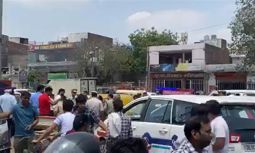
Stem the rot: Proactive steps need to be taken to prevent the terror attack on Nirankaris from turning into a festering wound.
P Lal
Former DG Police, Punjab
The attack by suspected terrorists in Satsang Bhawan of the Nirankaris in the Rajasansi area of Amritsar on November 18, resulting in the killing of three and injury to 22 necessitates proactive steps by the state to arrest the problem and prevent it from turning into a festering wound.
Pakistan role in terrorism
That Pakistan has a role through its state and non-state actors is a foregone conclusion, for without its covert support such a dastardly crime could not have taken place. This is amply shown by past such incidents, be it the Mumbai attacks of 2008, or the storming of the Indian Parliament (2001) or the attack on Indian Air Force station in Pathankot (2016).
The trouble in Punjab, when it started in the 1980s, had its genesis in Pakistan which thought that it could create Khalistan, an independent sovereign state, to avenge the creation of Bangladesh in 1971 for which India had provided a major military support. Pakistan's efforts, however, miserably failed for many reasons. Towards the end of the 1980s, Pakistan realised that it would be far better to concentrate on Kashmir than on Punjab. The shifting of its focus to Jammu and Kashmir altered the terrorist crime graph in the region. Such crime started rising in Jammu and Kashmir in the beginning of the 1990s, even as it started declining in Punjab. I had occasion to deal with a few of such terrorist crimes in Jammu and Kashmir as a member of the CBI team investigating four such cases, including the killings of HL Khera, General Manager of HMT, Mushir-ul-Haq, Kashmir University Vice-Chancellor, and seven Air Force personnel while they were standing on the road.
How Punjab militancy was arrested
Besides the change of focus by Pakistan from Punjab to Kashmir, there were other reasons, too, for the arrest of militancy in Punjab.
No such movement can sustain for long without a wide network of support in the form of men and material from locals as well as from abroad. This includes the supply of arms and ammunition, finances, training facilities and sheltering of fugitives. These activities are spread over different states and even moored in lands abroad. This certainly was the case when Punjab-related militancy raised its head in the early 1980s.
A coordinated action to deal with all such diversely located resources of militant movement is, therefore, necessary. But it has seldom been converted into a concrete architecture, primarily because the police is a state subject and the police of a state are ill prepared and don't have enough resources to tackle the multifarious dimensions of terrorist crimes and a militant movement.
Landmark dates
May 10 and 11 in 1985 proved to be landmark dates in the history of Punjab-related terrorism. On those two days, over 100 transistor bombs exploded in various places in Delhi, including buses and slum areas, killing 85. About 100 bombs were defused unexploded.
The Government of India swung into action immediately. It realised that terrorism and its perpetrators were not confined to Punjab, but had spilled over to other states, with grave danger to national security. Finances were coming from abroad, a network of shelters had been created in Uttar Pradesh, Rajasthan, Delhi and Haryana and the propaganda machinery was active in such far-flung countries as Canada, the UK and the USA.
Coordiantion panel set up
The Government of India, within a week of the May 10-11 mayhem, set up a structure at Chandigarh under the aegis of the CBI to coordinate inter-state and inter-agency actions against Punjab terrorism. Initially, five states (Punjab, Haryana, Uttar Pradesh, Himachal Pradesh and Jammu and Kashmir) and two UTs (Chandigarh and Delhi) besides the central agencies of RAW and IB were its members. Later, it was expanded to include Rajasthan and central forces like the BSF and CRPF and Revenue Intelligence.
I headed the coordination panel from 1985 to 1990 as DIG, CBI, Chandigarh. The panel had a dedicated and well-trained staff of interrogators — about 15 — who would interrogate important terrorists arrested in any of the states with perspectives different from those of a state police interrogator. They would then bring out details of their financial and other support structure and share the reports within 24 hours with the members of the coordination panel to enable them to take follow-up action in their respective areas.
As a convener of the coordination committee, the DIG CBI was required to ensure that the respective states and agencies did take action to block the channel of funds, to detain and interrogate the supporters and providers of shelters and to do myriad other things as required by disclosures in interrogation reports to thwart the current of terrorist movement. He also convened fortnightly meetings of members to share further information of interest and discuss the follow-up action.
The records of about 6,000 people-active terrorists, supporters and financiers etc were computerised, though computerisation was in its infancy in those days. It was promptly shared with member-states/agencies. Sharing was the bulwark of the panel, rather than cloak and secrecy (from one another).
The efforts of the coordination panel were appreciated by JF Ribeiro, the then Adviser to the Punjab Governor, in a reference to the Union Home Secretary. KPS Gill, the then DG Police, Punjab, and the then Governor Punjab also appreciated the efforts of the panel.
The strike at the Nirankari congregation in Rajasansi, Amritsar, is a signal which must be taken note of by the authorities. A formal coordination architecture needs to be set up to unearth different aspects of such terrorist crimes and take action to neutralise efforts to reassert militancy in Punjab and neighbouring areas, though the setting up of such a panel in itself would not be sufficient to stem the rot.



























